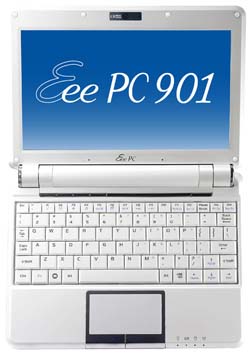Netbook roundup from Computex


The emergence of this category is fueled in part by Intel, which officially released its Atom processors and related chipsets. Atom is designed for two different types of products, Mobile Internets Devices (MIDs), which are essentially powerful handhelds with wireless WAN connectivity, and these ultra low-cost PCs, which Intel refers to as netbooks and nettops. Because of the low price tags, these stripped-down systems are geared toward both emerging markets and mature markets, where they're popular as a second or third PC for Web browsing and e-mail. Intel believes the category will grow to 100 million units by 2011--the majority of which will be netbooks.
The reason these have succeeded where subnotebooks with similar dimensions have in the past is price. A typical netbook with the 1.6GHz Atom N270, 512MB of memory, 2 to 4GB of flash storage, a 7- to 10-inch display and Windows XP or Linux should cost between $250 and $350. Nettops should be even less expensive--between $200 and $300 with the N270, a 1GB of memory, an 80GB hard drive and Windows XP or Linux. Some are already hitting these prices, such as models from Asus, but others are closer to $500 or $600. There's a practical reason for this: the volumes need to increase to bring down prices of components. But it is also a strategy for some OEMs to differentiate their netbooks with larger displays, more memory and other features.
Intel says it has 60 design wins for netbooks and nettops. At its booth, I saw netbooks from Asus, Acer, Gigabyte, Haier and MSI, as well as an update to its own Classmate PC. And there were nettops from Asus, EliteGroup, Lenovo, and others. Here are some of the more interesting models:
Asus hasn't been sitting still. Its two new Eee PCs weren't much of a secret, but it did launch them at the show. The Eee PC 901 is a refresh of the existing 8.9-inch model with the Atom N270, 1GB of memory, a 12GB SSD, 802.11n, and either Windows XP or Linux. The new Eee PC 1000 has a 10-inch display, Atom N270, 2GB of memory, and either a 40GB SSD or an 80GB standard HDD. The keyboard is also larger--about 92% of a full-size keyboard according to Asus--which addresses one of the knocks with smaller netbooks. Asus also launched an interesting nettop, the Eee Box, which is only an inch thick and rests vertically in a stand. The base configuration includes the Atom N270, 1GB of memory, an 80GB HDD, and Linux for $270 (the same model with Windows XP is $300).
The heavily hyped MSI Wind Notebook has a 10-inch LED backlit display as well as the Atom processor, up to 2GB of memory, an 80GB hard drive, 802.11b/g (but not -n). MSI also introduced a nettop, the Wind PC. It's a bit larger than the Eee Box--but still very compact--and uses the Atom N230, a 160GB HDD, and 802.11b/g. Because it draws only 35W full-out, MSI is pitching it as a green PC that saves on electricity costs and is very quiet during operation.